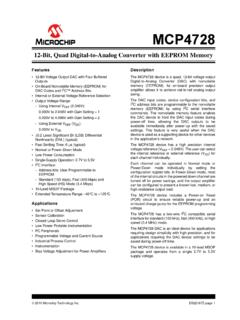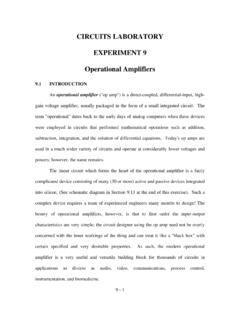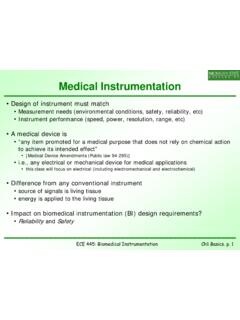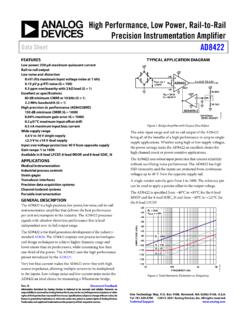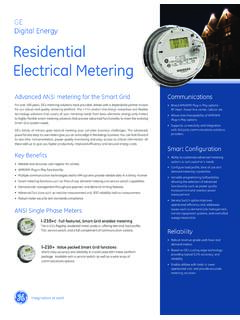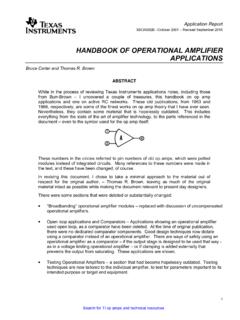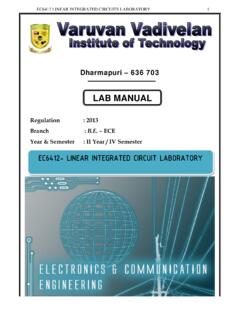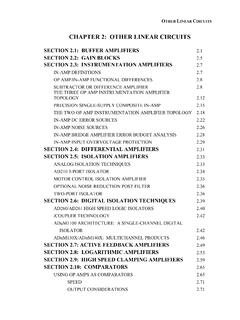Transcription of BASIC ELECTRONICS NOTES DEPARTMENT OF ELECTRONICS …
1 1 BASIC ELECTRONICS NOTES DEPARTMENT OF ELECTRONICS AND TELECOMMUNICATION ENGINEERING PREPARED BY SMRUTIREKHA PRUSTY 2 3 CHAPTER NAME PAGE NO MODULE -I TO SIGNAL 4-9 AMPLIFIERS 10-25 DIODES 26-50 MODULE-II JUNCTION TRANSISTORS 51-106 OXIDE SEMICONDUCTOR FIELD EFFECT TRANSISTORS 107-121 MODULE-III ELECTRONIC PRINCIPLES 122-129 GATES AND BOOLEAN ALGEBRA
2 129-135 4 MODULE-I ELECTRONICS ELECTRONICS comprises the physics, engineering, technology and applications that deal with the emission, flow and control of electrons in vacuum and distinguishes it from classical electrical engineering as it uses active devices to control electron flow by amplification and rectification rather than just using passive effects such as resistance, capacitance and inductance. INTRODUCTION TO SIGNAL Electric signals (in ELECTRONICS ) different voltages and currents in the electric network called electric circuit or device , which can be further described as the process of changes a certain physical quantity or state of a physical object over certain period of time.
3 They are used for the purpose of visualization, registration and transmission of messages (information). Signal can be a carrier of different information electric, magnetic and acoustic signals and contains the information parameter amplitude, frequency or pulse width. In ELECTRONICS , the most important signals are the changes in electric charge, current, voltage and electromagnetic field. They are used to analyze the behavior of electronic circuits or to measure the changing electrical values. What is Time Domain Analysis? A time domain analysis is an analysis of physical signals, mathematical functions, or time series of economic or environmental data, in reference to time.
4 Also, in the time domain, the signal or function's value is understood for all real numbers at various separate instances in the case of discrete-time or the case of continuous-time. Furthermore, an oscilloscope is a tool commonly used to see real-world signals in the time domain. Moreover, a time-domain graph can show how a signal changes with time, whereas a frequency-domain graph will show how much of the signal lies within each given frequency band over a range of frequencies. In general, when an analysis uses a unit of time, such as seconds or one of its multiples (minutes or hours) as a unit of measurement, then it is in the time domain.
5 However, whenever an analysis concerns the units like Hertz, then it is in the frequency domain. Frequency Domain In physics, ELECTRONICS , control systems engineering, and statistics, the frequency domain refers to the analysis of mathematical functions or signals with respect to frequency, rather than time. Put simply, a time-domain graph shows how a signal changes over time, whereas a frequency-domain graph shows how much of the signal lies within each given frequency band over a range of frequencies. A frequency-domain representation can also include information on the phase shift that must be applied to each sinusoid in order to be able to recombine the frequency components to recover the original time signal.
6 A given function or signal can be converted between the time and frequency domains with a pair of mathematical operators called transforms. An example is the Fourier transform, which converts a time function into a sum or integral of sine waves of different frequencies, each of which represents a frequency component. The "spectrum" of frequency components is the frequency-domain representation of the signal. The inverse Fourier transform converts the frequency-domain function back to the time function. A spectrum analyzer is a tool commonly used to visualize electronic signals in the frequency domain.
7 How is Time Domain Analysis Different from Frequency Domain? Frequency domain is an analysis of signals or mathematical functions, in reference to frequency, instead of time. As stated earlier, a time-domain graph displays the changes in a signal over a span of time, and frequency domain displays how much of the signal exists within a given frequency band concerning a range of frequencies. Also, a 5 frequency-domain representation can include information on the phase shift that must be applied to each sinusoid to be able to recombine the frequency components to recover the original time signal.
8 Furthermore, you can convert a designated signal or function between the frequency and time domains with a pair of operators called transforms. Moreover, a perfect example of a transform is the Fourier transform. Which converts a time function into an integral of sine-waves of various frequencies or sum, each of which symbolizes a frequency component. The so-called spectrum of frequency components is the frequency-domain depiction of the signal. However, as the name implies, the inverse Fourier transform converts the frequency-domain function back to the time function.
9 Elementary signals: The elementary signals are used for analysis of systems. Such signals are,1. Step 3. Ramp 6 ANALOG SIGNAL An analog signal is a continuous wave denoted by a sine wave (pictured below) and may vary in signal strength (amplitude) or frequency (waves per unit time). The sine wave's amplitude value can be seen as the higher and lower points of the wave, while the frequency value is measured in the sine wave's physical length from left to right. There are many examples of analog signals around us. The sound from a human voice is analog, because sound waves are continuous, as is our own vision, because we see various shapes and colors in a continuous manner due to light waves.
10 Even a typical kitchen clock having its hands moving continuously can be represented as an analog signal. DIGITAL SIGNAL: A digital signal is a signal that is being used to represent data as a sequence of discrete values; at any given time it can only take on one of a finite number of values. This contrasts with an analog signal, which represents continuous values; at any given time it represents a real number within a continuous range of values. Simple digital signals represent information in discrete bands of analog levels. All levels within a band of values represent the same information state.
